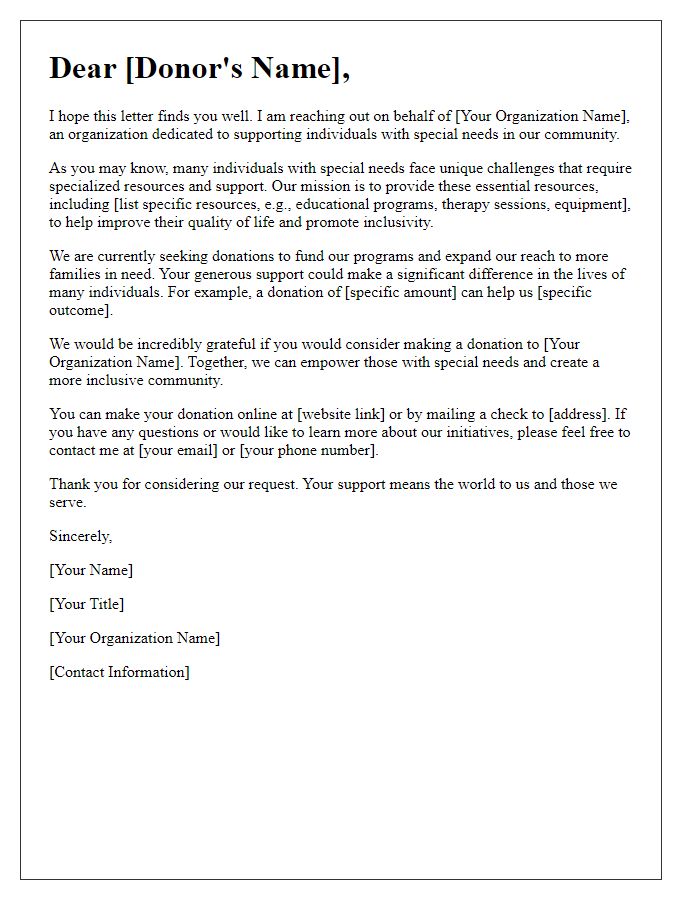Are you looking to secure funding for a special needs program that can truly make a difference? Crafting a compelling grant request letter is essential to convey your passion and the impact of your initiative. In this article, we'll explore key elements to include in your letter, ensuring it resonates with potential funders. Join us as we dive into effective strategies and tips to help you successfully request financial support for your special needs program!

Clear program objectives and goals
A well-defined special needs program should establish clear objectives and goals to ensure effective outcomes for participants, such as children with autism spectrum disorder (ASD) or learning disabilities like dyslexia. Program objectives may include enhancing communication skills through the implementation of speech therapy sessions, promoting social integration using structured group activities, or improving academic performance by providing tailored tutoring services. Specific measurable goals could target achieving a 20% increase in communication proficiency over six months or facilitating the participation of 30% of students in social skills workshops by the program's end. Additionally, tracking progress through assessments and feedback from educators, parents, and caregivers will ensure that the program remains adaptive to the unique needs of each participant, ultimately fostering their independence and quality of life.
Evidence of program impact and success
The special needs program at Redwood Community Center has significantly improved the quality of life for participants, enabling 150 individuals with developmental disabilities (like autism and Down syndrome) to achieve greater independence and social integration. Since the program's inception in 2020, attendance rates have increased by 40%, with a retention rate of 85% among participants, illustrating sustained engagement and satisfaction. Collaborative activities such as the annual "Ability Awareness Day" event, held in November, have fostered community support and awareness, drawing over 500 local attendees and showcasing participant achievements. Additionally, pre- and post-program assessments indicate a 60% increase in communication and social skills among participants, demonstrating measurable success and long-term impact. Funding from this grant will allow us to expand these successful initiatives, reaching more individuals across the region.
Detailed budget breakdown
Creating a detailed budget breakdown for a special needs program grant request involves clearly outlining all anticipated costs associated with the program. Key components typically include personnel costs, which may encompass salaries for specialized staff such as occupational therapists and educational specialists, alongside benefits. Equipment expenses highlight necessary tools such as assistive technology devices (like speech-generating devices priced around $3,000) and customized furniture suitable for individuals with mobility challenges. Additionally, program supplies should be accounted for, including educational materials specifically designed for special education. Training and professional development costs for staff to enhance their skills in working with special needs populations also form an essential part of the budget. Lastly, operational expenses like facility rentals or utility costs must be included, ensuring transparency in the funding request to maximize the program's impact on the community served.
Alignment with grantor's mission and values
Developing tailored programs for special needs individuals aligns closely with the missions of grantors focused on inclusivity and empowerment. Initiatives that foster skills development, enhance social integration, and provide resources for families serve to uplift communities. For example, organizations like the Autism Society of America emphasize community support, education, and advocacy, reflecting their commitment to improving the lives of those affected by autism. Similarly, the Individuals with Disabilities Education Act (IDEA) underscores the importance of accessible education, ensuring eligibility for funding that promotes innovative educational pathways. By submitting requests that highlight measurable outcomes and community impact, proposals can demonstrate alignment with these foundational values and objectives. Additionally, case studies showcasing successful program implementations can illustrate potential benefits for both participants and the broader community.
Testimonials or case studies from beneficiaries
Case studies of beneficiaries in special needs programs, such as adaptive educational initiatives, highlight transformative impacts on individuals and families. For instance, a 12-year-old boy named Jason, diagnosed with autism spectrum disorder, benefited from an inclusive classroom setup at Riverside Elementary School, leading to a significant improvement in social interactions and academic performance. Parents reported higher confidence levels in Jason, especially noted during the school's annual talent show where he performed in front of peers. Similarly, Maria, a 10-year-old girl with cerebral palsy, gained mobility skills through a tailored physical therapy program at Sunshine Rehabilitation Center. Her success in completing a 5K race with her family showcased the program's effectiveness, inspiring not only her personal growth but also facilitating a deeper community connection and awareness of special needs challenges.
Letter Template For Special Needs Program Grant Request Samples
Letter template of partnership proposal for special needs community development

Letter template of support request for special education curriculum enhancement












Comments